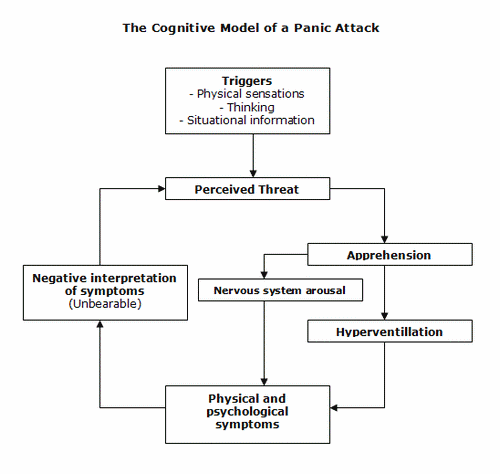Panic Disorder
If you (or someone close to you) ever experienced a
panic attack, you may know that it is an intense and often frightening
experience. Thinking becomes confused and focused on some indescribable
threat, concentration becomes difficult, heart rate increases rapidly, the
muscles tense up, your chest tightens and your breathing
speeds up. People often feel that something awful is about to happen,
although they are unable to describe exactly what.
The
Nature of Panic
Panic attacks are
relatively common and many people experience occasional episodes of panic
(for symptoms of a panic attack, click here). Panic
disorder develops when people experience repeated panic attacks for no
reason and become concerned about future episodes.
What maintains
a panic disorder is the catastrophic interpretation of physical symptoms
and the apprehension about future attacks. When people with panic disorder
are exposed to triggers (e.g., increased heart rate after running to catch
the bus or entering an area where a previous panic attack occurred)
they interpret their initial physical sensations as threatening. In turn,
they react with apprehension, which intensifies the
physical symptoms. As the symptom severity increases, people find it more
difficult to tolerate the physical sensations. The result is a downward
spiral, that once established becomes difficult to break. A
simplified model of panic is presented below:

(The
model is based on: Salkovskis,
1988.)
Situational Fears
People with
panic disorder often develop situational fears. They learn that having a
panic attack in a certain situation is more embarrassing or difficult than
in others. These may include being in public places, board meetings, while
driving or travelling on public transport and so on. Other times a
situation or people are associated with panic because an episode may
occurred in a certain situation or in the presence of certain individuals.
In both cases, situational fears can lead to avoidance. Although avoidance
may seem to "work" in reducing the possibility of a panic attack, in
reality panic attacks are often unrelated to situations and avoidance can
worsen the overall condition.
Symptoms of Panic
Disorder
 |
-
Recurrent experiences of unexpected and sudden
panic attacks.
-
Concern about having additional panic
attacks. The concern develops within a month from a panic
episode.
-
Worry about the possible consequences of panic
attacks (e.g., losing control, having a heart attack, "going
mad"...etc).
-
Behaviour is adjusted to cope with or to
avoid further panic attacks.
-
No presence of Agoraphobia.
-
The panic attacks are not elicited by prescribed
or illicit drug use and are not related to a medical
condition.
-
The panic attacks are not part of another anxiety
disorder (e.g., social
anxiety). |
Treatment of Panic Disorder
Panic disorder is
perhaps the most easily treatable psychological difficulty. The treatment
choice is imaginary and actual exposure. In treatment people learn
that the physical symptoms of panic attacks are harmless. Since panic
disorder is generally a "fear of fear", the most important aspect of
treatment is the reduction of apprehension about panic
attacks.
In our practice we teach people how to think differently
about panic and how to manage their experiences of panic differently. We
teach various relaxation strategies and self observation skills. Most
people report improved functioning after a brief period of treatment
and continue to apply the skills they learned in therapy sessions.